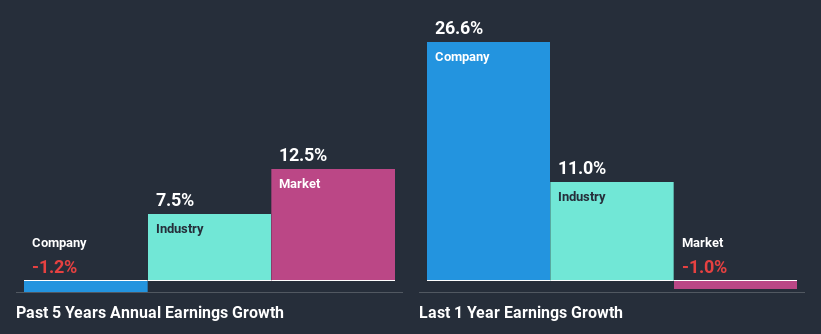- United States
- /
- Beverage
- /
- NasdaqCM:WVVI
Willamette Valley Vineyards, Inc.'s (NASDAQ:WVVI) Financials Are Too Obscure To Link With Current Share Price Momentum: What's In Store For the Stock?

Willamette Valley Vineyards' (NASDAQ:WVVI) stock up by 5.2% over the past three months. However, we decided to study the company's mixed-bag of fundamentals to assess what this could mean for future share prices, as stock prices tend to be aligned with a company's long-term financial performance. Particularly, we will be paying attention to Willamette Valley Vineyards' ROE today.
Return on Equity or ROE is a test of how effectively a company is growing its value and managing investors’ money. In short, ROE shows the profit each dollar generates with respect to its shareholder investments.
View our latest analysis for Willamette Valley Vineyards
How Do You Calculate Return On Equity?
Return on equity can be calculated by using the formula:
Return on Equity = Net Profit (from continuing operations) ÷ Shareholders' Equity
So, based on the above formula, the ROE for Willamette Valley Vineyards is:
6.2% = US$3.2m ÷ US$51m (Based on the trailing twelve months to September 2020).
The 'return' is the income the business earned over the last year. So, this means that for every $1 of its shareholder's investments, the company generates a profit of $0.06.
Why Is ROE Important For Earnings Growth?
So far, we've learned that ROE is a measure of a company's profitability. Based on how much of its profits the company chooses to reinvest or "retain", we are then able to evaluate a company's future ability to generate profits. Assuming everything else remains unchanged, the higher the ROE and profit retention, the higher the growth rate of a company compared to companies that don't necessarily bear these characteristics.
A Side By Side comparison of Willamette Valley Vineyards' Earnings Growth And 6.2% ROE
On the face of it, Willamette Valley Vineyards' ROE is not much to talk about. Next, when compared to the average industry ROE of 18%, the company's ROE leaves us feeling even less enthusiastic. Therefore, Willamette Valley Vineyards' flat earnings over the past five years can possibly be explained by the low ROE amongst other factors.
Next, on comparing with the industry net income growth, we found that the industry grew its earnings by7.5% in the same period.

Earnings growth is an important metric to consider when valuing a stock. The investor should try to establish if the expected growth or decline in earnings, whichever the case may be, is priced in. Doing so will help them establish if the stock's future looks promising or ominous. One good indicator of expected earnings growth is the P/E ratio which determines the price the market is willing to pay for a stock based on its earnings prospects. So, you may want to check if Willamette Valley Vineyards is trading on a high P/E or a low P/E, relative to its industry.
Is Willamette Valley Vineyards Efficiently Re-investing Its Profits?
Conclusion
On the whole, we feel that the performance shown by Willamette Valley Vineyards can be open to many interpretations. Even though it appears to be retaining most of its profits, given the low ROE, investors may not be benefitting from all that reinvestment after all. The low earnings growth suggests our theory correct. Up till now, we've only made a short study of the company's growth data. So it may be worth checking this free detailed graph of Willamette Valley Vineyards' past earnings, as well as revenue and cash flows to get a deeper insight into the company's performance.
If you decide to trade Willamette Valley Vineyards, use the lowest-cost* platform that is rated #1 Overall by Barron’s, Interactive Brokers. Trade stocks, options, futures, forex, bonds and funds on 135 markets, all from a single integrated account. Promoted
Valuation is complex, but we're here to simplify it.
Discover if Willamette Valley Vineyards might be undervalued or overvalued with our detailed analysis, featuring fair value estimates, potential risks, dividends, insider trades, and its financial condition.
Access Free AnalysisThis article by Simply Wall St is general in nature. It does not constitute a recommendation to buy or sell any stock, and does not take account of your objectives, or your financial situation. We aim to bring you long-term focused analysis driven by fundamental data. Note that our analysis may not factor in the latest price-sensitive company announcements or qualitative material. Simply Wall St has no position in any stocks mentioned.
*Interactive Brokers Rated Lowest Cost Broker by StockBrokers.com Annual Online Review 2020
Have feedback on this article? Concerned about the content? Get in touch with us directly. Alternatively, email editorial-team (at) simplywallst.com.
About NasdaqCM:WVVI
Willamette Valley Vineyards
Produces and sells wine in the United States and internationally.
Mediocre balance sheet and slightly overvalued.
Similar Companies
Market Insights
Community Narratives



